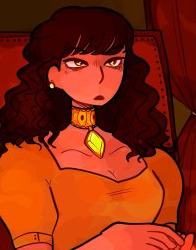#maida
Explore tagged Tumblr posts
Text
Maida vs. Mina


Propaganda for Maida:
She's slaying (gods) fr, my killer queen, my everything, free my girl she did all of it, my wet little ragdoll cat, she has sooooo many issues and she’s causing people sooooo many issues, I’m just gonna submit the link to the viva la vida animatic: https://www.youtube.com/watch?v=6z-ICaQlOeQ
Propaganda for Mina:
i love mina for multiple things. one - her colors and ghost design. two - her lore. three - her animatics!!! shes one of my favorite characters of all time!! shes so pretty and her lore is so interesting so my vote goes for mina!!
SHES THE BEST AND THE LOML
shes just a girl ok!!!!
She's so complex and well-written! Her design is beautiful as well, and she is such an important part to the Villain Trio lore, and she is always such a highlight to see Elliot post! Her story, her character, her design, everything about her is peak lol I am the #1 Mina Ito stan and she deserves acclaim
47 notes
·
View notes
Text
I love Maida!

I couldn’t resist drawing her curly hair
42 notes
·
View notes
Text
quick video talking about Maida from the old recording I thought was interesting
34 notes
·
View notes
Text
POV: You’re in a Teams meeting and you perceive rustling and chirping to your right



#Maida#bby girl why#her handbag now#that her spot on the couch (hence the missing cushion) so I only got myself to blame#working from home be like#kisse!
196 notes
·
View notes
Text










Calabria, Italy
A slow rhythm, considered lame in the 21st century, but its limping nature is its only strength.
Calabria can bet on its authenticity, on its lack of filters, on its truths to become a promoter of sustainability, of positive models, of rediscovery of peculiarities.
Photos by Racconti raminghi e altre storie
Follow us on Instagram, @calabria_mediterranea
#cortale#maida#jacurso#calabria#italy#italia#south italy#southern italy#italian#mediterranean#europe#landscape#italian landscape#architecture
33 notes
·
View notes
Text

Making soft and fluffy parottas is now possible even at home. With its fine texture and superb quality, Sunraja Daily Maida will save you a trip to a restaurant for your favourite parotta.
Use code MAR10 to avail 10% discount T&C apply. Shopping links are in bio
0 notes
Text
5 key factors to keep in mind while choosing the best Maida suppliers

India is among the largest providers of maida (refined wheat flour) due to the wide cultivation of wheat. In most Indian households and the food industry, Maida is used to prepare many products including breads, cookies, cakes, puff pastries, and Indian snacks. Getting better results is important to get products from the top maida suppliers in India.
#Maida Suppliers in India#Maida#Wheat Flour#atta manufacturers in india#flour manufacturers#flour grain#flour mill
1 note
·
View note
Text
1 note
·
View note
Text

#Premium Maida Exporter in India#Maida Supplier in Karnataka#Wheat Flour Wholesaler in India#Premium Maida#Maida#Supplier#Exporter#Karnataka#India#best quality Premium Maida
0 notes
Text
Punjabi Samosa Recipe**Ingredients:*- Boiled potatoes- Jeera (cumin seeds)- Hari dhania (fresh coriander leaves)- Peas- Salt- Red chili powder- Chatmasala- Ghee (clarified butter)- Water- Maida (all-purpose flour)- Green chutney- Ketchup- Chatmasala (again, for serving)- Egg (optional)*Instructions:*read more
0 notes
Text
MINA SWEEPPPPPP!!!!
Maida vs. Mina


Propaganda for Maida:
She's slaying (gods) fr, my killer queen, my everything, free my girl she did all of it, my wet little ragdoll cat, she has sooooo many issues and she’s causing people sooooo many issues, I’m just gonna submit the link to the viva la vida animatic: https://www.youtube.com/watch?v=6z-ICaQlOeQ
Propaganda for Mina:
i love mina for multiple things. one - her colors and ghost design. two - her lore. three - her animatics!!! shes one of my favorite characters of all time!! shes so pretty and her lore is so interesting so my vote goes for mina!!
SHES THE BEST AND THE LOML
shes just a girl ok!!!!
She's so complex and well-written! Her design is beautiful as well, and she is such an important part to the Villain Trio lore, and she is always such a highlight to see Elliot post! Her story, her character, her design, everything about her is peak lol I am the #1 Mina Ito stan and she deserves acclaim
47 notes
·
View notes
Text

Kitty Cat watching for birds
5 notes
·
View notes
Text

Twice roasted, twice the taste! 🔥✨ Sunraja Daily Double Roasted Sooji – for fluffier upmas, crispier halwas, and happier meals!
0 notes
Text
Best Ever Garlic Naan Recipe 30 मिनट में बनायें बाजार जैसी नान No Tandoor No Oven
आपने गार्लिक नान या तंदूरी नान बहुत बार खाई होगी। यह खाने में जितनी टेस्टी होती है बनाने में थोड़ा सा कंप्लीटेड होती है, लेकिन आज हम इसको बहुत ही सिंपल तरीके से आपको बनाना सिखाएंगे कि कैसे आप घर पर ही गार्लिक नान बनाकर बच्चों को टिफिन या फिर नाश्ते में सर्व कर सकते हैं। गार्लिक नान वैसे तो तंदूर के ऊपर बनाई जाती है लेकिन हम आपको यहां गैस के तवे पर ही गार्लिक नान बनाने की विधि आपसे शेयर करने वाले…

View On WordPress
0 notes
